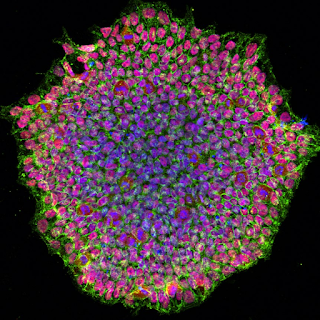 |
| Stem Cell |
Navigating the regulatory regimes that govern drug safety can be challenging. But, rigorous standards are more relaxed in the lesser used track for autologous and/or minimally manipulated cell treatments. Toward meeting the challenges of this minimal regulation track, the wide-spectrum of NK cells, of the innate immune system, are compelling candidates to address complex cellular and tissue personalization's or conditions of disease. One effect of cell function on NK cell potency occurs via aryl hydrocarbon receptor (AhR) dietary ligands, potentially explaining numerous associations that have been observed in the past.
The AhR was first identified to bind the xenobiotic compound dioxin, environmental contaminants and toxins in addition to a variety of natural exogenous (e.g., dietary) or endogenous ligands and expression of AhR is also induced by cytokine stimulation. Activation with an endogenous tryptophan derivative, potentiates NK cell IFN-γ production and cytolytic activity which, in vivo, enhances NK cell control of tumors in an NK cell and AhR-dependent manner.
A combination of ex vivo and in vivo studies revealed that Acute Myeloid Leukemia (AML) skewed Innate Lymphoid Cell (ILC) Progenitor towards ILC1's and away from NK cells as a major mechanism of ILC1 generation. This process was driven by AML-mediated activation of AhR, a key transcription factor in ILC's, as inhibition of AhR led to decreased numbers of ILC1's and increased NK cells in the presence of AML.
Activation of AhR also induces chemoresistance and facilitates the growth, maintenance, and production of long-lived secondary mammospheres, from primary progenitor cells. AhR supports the proliferation, invasion, metastasis, and survival of the Cancer Stem Cells (CSC's) in choriocarcinoma, hepatocellular carcinoma, oral squamous carcinoma, and breast cancers leading to therapy failure and tumor recurrence.
Loss of AhR increases tumorigenesis in p53-deficient mice and activation of p53 in human and murine cells, by DNA-damaging agents, differentially regulates AhR levels. Activation of the AhR/CYP1A1 pathway induces epigenetic repression of many tumor suppressor and tumor activating genes, through modulation of their DNA methylation, histone acetylation/deacetylation, and the expression of several miRNAs.
p53 is barely detectable under normal conditions, but levels begin to elevate and locations change particularly in cells undergoing DNA damage. The significant network effect of p53 availability and its mutational status in cancer makes it the worlds most widely studied gene.
From 48 sequenced samples of two different tumors, Codondex identified 316 unique Key Sequences (KS) of the TP53 Consensus. 9 of these contained the core AhR 5′-GCGTG-3′ binding sequence, and some overlapped p53 quarter binding sites as illustrated below;
Key Sequence
GGATAGGAGTTCCAGACCAGCGTGGCCA (intron1) AhR [1699,1726], p53 @ [1706,1710]
AAAAATTAGCTGGGCGTGGTGGGTGCCT (intron1) AhR [1760,1787], p53 [1783,1787]
GAGGCTGAGGAAGGAGAATGGCGTGAAC (intron6) AhR [12195,12222]
We propose that DNA damage liberates transposable DNA elements that are normally repressed by p53 and other suppressor genes. The p53 repair/response also includes increased cooperation between p53 and AhR, which further influence transcription, mRNA splicing or post-translation events. Repeated damage, at multi-cellular scale, may proximally bias ILC's toward NK cells capable of specific non-self detection, through localized ligand, receptor relationships that trigger cytolysis and immune cascades.
KS's are a retrospective view of transcripts ncDNA elements, ranked by cDNA that may reflect inherent bias that can be used to direct NK cell education. One way to accomplish minimal manipulation may be to leverage patient immunity by educating autologous NK cells with computationally selected tumor cells, identified by KS alignments to the index of past experiments that expanded and triggered a more desirable immune response. Customizable immune cascades, capable of managing disease or preventatively supporting a desired heterogeneity being the primary objective.
No comments:
Post a Comment